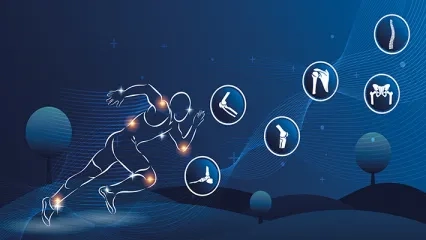Alo Yeditepe
Alo Yeditepe
Robotic Hip Replacement Surgery
Robotic Hip Replacement Surgery
Hip pain, limited mobility and joint deformities can significantly reduce quality of life. If your hip joint is severely damaged and conservative treatments (medications, physical therapy, injections) are inadequate, hip replacement may be necessary.
What is Robotic Hip Replacement Surgery?
One of the most important conditions that increase the success of hip replacement and allow patients to use their prosthesis comfortably in the long term is the placement of the hip prosthesis in the appropriate position for the patient. One of the most important supports used to place the prosthesis in the most appropriate position for the patient's anatomy is robotic hip replacement, which has become increasingly popular in recent years.
This technology is especially applied in patients with hip pain and mobility difficulties that significantly limit daily living activities and offers many advantages over traditional methods.
Who Can Receive Robotic Hip Replacement Surgery?
Patients with damaged articular cartilage due to osteoarthritis (calcification);
Among the main patient groups where robotic hip replacement is applied are individuals with severe damage to the articular cartilage due to osteoarthritis (calcification). This condition, which is especially common in individuals over the age of 50, is characterized by wear in the joints and friction of the bones against each other.
Patients with inflammatory joint diseases such as rheumatoid arthritis;
Patients who develop deformity in the hip joint due to rheumatoid arthritis and other inflammatory joint diseases are also suitable candidates for robotic prosthesis application. In these cases caused by the immune system attacking the joints, a precise prosthesis placement can be achieved with the robotic system in pain and deformities that cannot be controlled with drug treatment.
Patients with bone loss due to avascular necrosis;
Robotic hip prosthesis is an effective solution in cases of tissue loss known as avascular necrosis (bone death), which occurs when the blood supply to the hip bone is interrupted. In this case, which requires prosthesis if not intervened at an early stage, joint movement can be provided with the prosthesis.
Patients with developmental hip dysplasia or trauma-related hip deformity;
In patients with congenital developmental hip dysplasia or post-traumatic hip deformities, anatomical harmony can be maximized thanks to robotic planning.
Patients who have had previous prosthesis surgery and have developed wear, loosening or infection in the prosthesis;
Revision surgery can be performed much more safely with robotic technology in patients who have previously undergone prosthesis surgery and have developed wear, loosening or infection in the prosthesis.
What are the Advantages of Robotic Hip Replacement Surgery?
Personalized planning and precise placement
One of the most important advantages of robotic hip replacement over traditional methods is the possibility of personalized planning and precise placement. Thanks to the possibility of planning in accordance with the anatomy of each patient, joint movement after surgery is greater and the patient's gait is better.
Longer lasting prosthesis: By analyzing the patient's anatomy in detail with preoperative 3D imaging, prosthetic components can be placed with a margin of error of less than 0.5 mm. This prolongs the life of the prosthesis and significantly reduces the risk of reoperation.
Faster recovery and less pain
Another important advantage of robotic surgery is that it causes less tissue damage and can be performed with minimally invasive techniques. Thanks to the ability of robotic arms to work through small incisions, muscle and connective tissue can be preserved, resulting in less postoperative pain and faster recovery.
Near-natural mobility
One of the most important gains for patients is that the robotic hip prosthesis provides near-natural mobility. Thanks to the placement of the prosthesis in accordance with the natural joint movement of the person, movements such as walking, climbing stairs and squatting can be done much more comfortably. The postoperative recovery process also progresses quite rapidly in robotic surgery.
Shorter hospital stays
In conclusion, robotic hip replacement offers a safer, more precise and personalized treatment option compared to traditional methods. Thanks to its advantages such as less risk of complications, longer prosthesis life and faster healing process, it has become an important treatment option for patients with hip joint problems. Individuals whose quality of life has decreased due to hip pain are recommended to consult specialist orthopedic physicians for detailed information about robotic prosthesis surgery.
How is Robotic Assisted Hip Replacement Surgery Performed?
A meticulous preliminary preparation is made before robotic assisted hip replacement surgery. The experience of the physician is also extremely important in this surgery, which is performed with the support of advanced technology.
Evaluation of the patient and planning of the surgery
Before surgery, the patient's hip joint is examined in detail with three-dimensional imaging techniques. In the light of the data obtained, the surgeon prepares a personalized surgical plan with the help of the robotic system. Important factors such as the size, angle and position of the prosthesis are determined in a way that best suits the patient's anatomical structure.
Performing the surgical procedure
During the surgical intervention, the robotic system works under the guidance of the surgeon, ensuring that the prosthesis is placed at the pre-planned point with great precision. Robotic technology provides both visual and mechanical feedback to the surgeon, minimizing the risk of error and increasing the success of the operation.
Postoperative recovery
Thanks to the precision provided by the robotic system, patients have a faster and more comfortable postoperative recovery. They can usually start walking within a few days after the operation and return to their daily lives in a short time.
This method increases surgical success rates and offers a safer and more effective solution for both the patient and the surgeon. Robotic hip replacement surgeries set a new standard in the field of orthopedics as one of the innovative approaches offered by modern medicine.
Frequently Asked Questions About Robotic Hip Replacement Surgery
What is the Recovery Process of Robotic Surgery?
Since robotic hip replacement surgery is performed with minimally invasive techniques, muscle and connective tissue are preserved, postoperative pain is less and the healing process is accelerated. Patients can stand up within 24 hours and return to their daily activities within 4-6 weeks.
Can Robotic Hip Replacement be Applied to Every Patient?
Robotic hip replacement may not be suitable for every patient. The presence of uncontrolled infection, some patients with severe osteoporosis, people who are risky to receive general anesthesia and individuals with extreme obesity may pose some difficulties in the application of this method.
How is the mobility of patients affected after robotic hip replacement surgery?
Since the prosthesis is placed in accordance with natural joint movement, patients can perform movements such as walking, climbing stairs and squatting more comfortably.
Why Should Robotic Hip Replacement be Preferred?
It is a safer option compared to traditional methods as it offers longer prosthesis life, less risk of complications and a fast recovery process.
This content was prepared by Yeditepe University Hospitals Medical Editorial Board.
”
See Also
- What are Hip Joint Diseases? Causes and Treatment
- Knuckle Cracking Can Be Dangerous When It Becomes a Habit!
- Things to Consider When Walking in Snowy Weather
- What is Hallux Rigidus (Stiff Big Toe/Toe Arthritis)? Symptoms and Treatment
- What is Hallux Valgus (Bunion)? How is it Treated?
- Meniscus and Cartilage Transplantation Can Be Done at the Same Time
- Knee Pain
- Ergonomics in Automobiles Prevents Accidents
- Don't Underestimate Bone Pain That Doesn't Make You Sleep and Doesn't Relieve With Medication
- Joint Pain and Causes of Joint Pain
- Walking and Returning to Social Life After Knee Replacement Surgery
- What Are the Advantages of Robotic Knee Replacement Surgery?
- Robotic Knee Prosthesis Surgery
- What Causes Hip Pain? How Does Hip Pain Go Away?
- The Usage Area of Robotic Surgery Expands in Orthopedic Surgeries
- Higher Risk of Anterior Cruciate Ligament and Ankle Injury in Female Athletes
- Patients Who Undergo Joint Replacement Surgery Can Stand Up and Walk the Next Day
- Spinal Fractures
- Big Toes Can Be A Big Problem!
- What is Synovitis in Joints?
- Hip Osteoarthritis and Hip Prosthesis
- Hip Impingement Syndrome
- What is the Future of Treating Cartilage Problems?
- Not Only Athletes Suffer from Meniscus Tears!
- Is Cartilage Damage More Common in Those Who Run for Long Periods?
- Beware If Your Shoulder Or Neck Pain Lasts Longer Than Two Days After Swimming!
- Mistakes While Swimming Can Cause Shoulder Pain
- What is a Stress Fracture? How to Treat Stress Fracture?
- Myths About Fractures
- Vitamin D Deficiency May Be The Cause Of Your Joint Pain
- The First Onset of Pain in Cartilage Damage in the Knee Should Not Be Overlooked
- Have Your Baby Take Their First Steps in Good Health
- Heavy School Bags Can Cause Pain in the Lower Back, Shoulders, and Hands!
- Sports Injuries
- Cartilage Transplantation from Donor Has Been Started to Perform in Turkey
- Working From Home Increases Waist and Neck Problems
- First Cartilage Transplant from a Donor
- Pay Attention to the Pain That Occurs in the Front Part of Your Knees While Playing Sports!
- 8 Common Misconceptions About Sports Injuries
- Young Patient Who Could Not Walk Due to Cartilage Damage Recovered With Cartilage Transplantation
- Knee Arthritis
- Biopsy for Bone and Soft Tissue Tumors
- Knee Pain
- Crunching in the Kneecap May Be a Sign of Calcification
- Injured Athletes Can Return To Sports With Cartilage Transplant
- Treatment of Knee Arthrosis Varies According to the Person
- A Lack of Attention to Sports Injuries in Children May Affect Their Development
Alo Yeditepe




